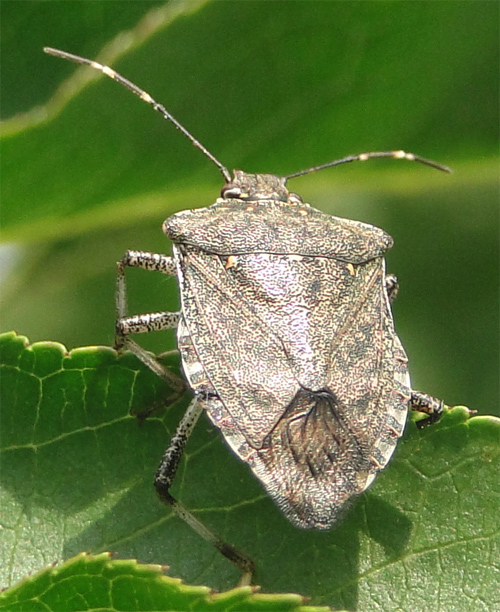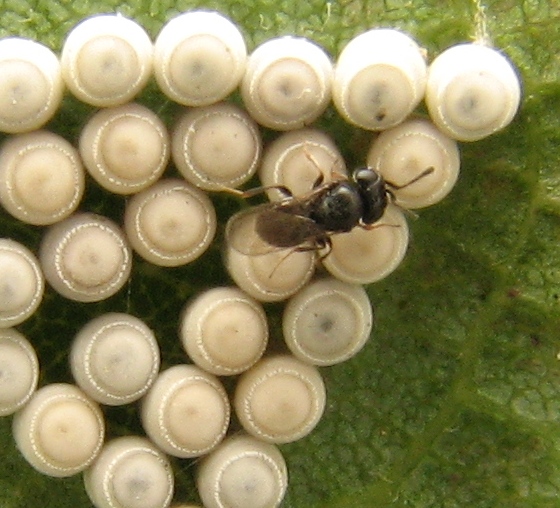This Bug's a Bummer!
On a daily basis, entomologists scoop up tarantulas lovingly and avidly spear dead beetles with pins. But there is one type of bug that no amount of affection for creepy-crawlies can redeem in their eyes: the brown marmorated stink bug.
Entomologists hate this insect. Brown and streaked like marble, the bugs are less than an inch long and are shaped like shields. After arriving from Asia in the 1990s, they have become the bane of U.S. agriculture. The bugs swarm in huge numbers to attack soybeans, corn, apples, pears, peaches, and more. They suck juices from the fruits, leaving brown sores and dents. No customers want to buy blemished produce; as a result, the bugs are driving farmers and orchard growers across the mid-Atlantic and South states out of business.

Brown marmorated stink bugs descend on farms and orchards and leave fruit brown and dented that cannot be sold. The bugs are creating enormous economic damage. (Image by Doug Pfeiffer from here.)
The National Museum of Natural History's entomological collection houses examples of brown marmorated stink bugs, along with its 35 million other specimens. We reach the collection through a series of hallways and back elevators, and stand among the tall metal lockers, full of trays stacked on top of one another. Each tray contains dozens of bugs and is covered with a sheet of glass. Gary Hevel, Public Information Officer Emeritus for the Smithsonian Department of Entomology, gives us a tour. He is wearing a tie decorated with large illustrated red ladybugs. A gold pin stabs through the belly of one of the ladybugs, holding the tie in place over his shirt. He wears matching red suspenders.
Hevel is a devoted bug collector. In the year 2000, he decided to survey the biodiversity that exists in his own backyard in Silver Spring, Maryland. Over the course of four years, he found, collected, identified, and preserved over 4,000 insect species. That's not 4,000 specimens -- he found many hundreds or thousands each of the more common types of insects -- but 4,000 distinct species. He has meticulously organized his discoveries into a collection that fills many wooden trays, each one dotted with hundreds of bugs. Some are so small that they couldn't fit on a pin and had to be glued to a piece of cardstock. His collection demonstrates the astounding number of different species that exist not just in exotic jungles or faraway deserts, but in our own subdivisions and backyards.
As many farmers and orchard growers have done, Hevel collected brown marmorated stink bugs with disgust. He found them not only in his backyard, but in his house. That's because when they're not in the fields injuring fruit, these critters spend their time in wooden structures like barns, office buildings, and homes. At the start of winter, they scuttle in by the hundreds through chimneys and cracks around doors. Homeowners across the United States have come to know and detest them.

A brown marmorated stink bug. (Image by Doug Pfeiffer from here.)
Some farmers use insecticides to protect their crops from the bugs. These sprays don't always work well, and some have the potential downside of harming both human health and the environment. Organic farmers have no line of defense at all; their crops fall prey to the stink bugs whenever a swarm happens to arrive.
Because of these problems, scientists at the United States Department of Agriculture and elsewhere are looking for a long term solution. They aren't concocting chemical mixes or looking for knives sharp enough to kill the pests. Instead, their interest is in biological mechanisms of control -- living weapons that can combat the invaders. One potential biological army could be composed of members of the wasp genus Trissolcus. These tiny wasps -- less than two millimeters long when fully grown -- are stink bugs' natural enemies. The female locates stink bug eggs, breaks into them, and lays her own eggs inside of them. When the wasp's larva hatches, it eats the contents of the stink bug egg, preventing the baby bug from maturing. Because of the wasp's inherent aptitude for destroying stink bugs, scientists are considering releasing large numbers of them into the wild. Ideally, enough wasps could depress the stink bug population.

A member of the Trissolcus wasp genus crawls over stink bug eggs. (Image by Beatriz Moisset from here.)
Before they scatter the wasps into the wild in droves, however, scientists must ensure that doing so will not cause major ecological side effects. Let's say the wasp turned out to be the preferred food of a particular type of spider that bites and injures cattle. Increasing the numbers of wasps would drive up the spider population. More spiders would injure more cattle, potentially to the detriment of the meat or dairy industries. Tinkering with any species' place in the food chain is a risky business and can cause unwanted domino effects if done poorly. Scientists, therefore, wish to ensure that the wasps will be a harmless addition to the American landscape before using them to create a stink bug-hunting mob.
Hevel clearly hopes that the scientists are soon able to release the wasps. To demonstrate his hatred of stink bugs, he has reserved a drawer of his collection especially for the single species. He holds up the tray for us to see its contents. Across the white bottom are clearly legible the words "BROWN MARMORATED STINK BUG." Each letter of each word is composed of between six and ten stink bugs, arranged to look like a letter and pinned in place. The whole thing is framed like piece of art -- albeit, one for which you'd need either a cruel sense of humor or a deep-seated loathing for stink bugs to enjoy.
Hevel held up the framed bugs as the group of onlookers gasped and giggled. As they took pictures and stared, he said wryly, "I got revenge."

Hevel with his creation. (Image by Lauren DiVito.)
Gary Hevel gave the tour mentioned above of the National Museum of Natural History's entomological collection as part of the Smithsonian Science Educational Academies for Teachers Biodiversity Week.
